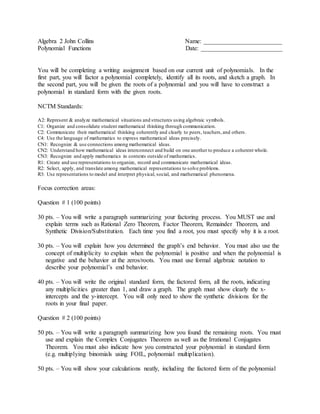
Polynomial John Collins
- 1. Algebra 2 John Collins Name: _________________________ Polynomial Functions Date: __________________________ You will be completing a writing assignment based on our current unit of polynomials. In the first part, you will factor a polynomial completely, identify all its roots, and sketch a graph. In the second part, you will be given the roots of a polynomial and you will have to construct a polynomial in standard form with the given roots. NCTM Standards: A2: Represent & analyze mathematical situations and structures using algebraic symbols. C1: Organize and consolidate student mathematical thinking through communication. C2: Communicate their mathematical thinking coherently and clearly to peers, teachers,and others. C4: Use the language of mathematics to express mathematical ideas precisely. CN1: Recognize & use connections among mathematical ideas. CN2: Understand how mathematical ideas interconnect and build on one another to produce a coherent whole. CN3: Recognize and apply mathematics in contexts outside of mathematics. R1: Create and use representations to organize, record and communicate mathematical ideas. R2: Select, apply, and translate among mathematical representations to solve problems. R3: Use representations to model and interpret physical, social, and mathematical phenomena. Focus correction areas: Question # 1 (100 points) 30 pts. – You will write a paragraph summarizing your factoring process. You MUST use and explain terms such as Rational Zero Theorem, Factor Theorem, Remainder Theorem, and Synthetic Division/Substitution. Each time you find a root, you must specify why it is a root. 30 pts. – You will explain how you determined the graph’s end behavior. You must also use the concept of multiplicity to explain when the polynomial is positive and when the polynomial is negative and the behavior at the zeros/roots. You must use formal algebraic notation to describe your polynomial’s end behavior. 40 pts. – You will write the original standard form, the factored form, all the roots, indicating any multiplicities greater than 1, and draw a graph. The graph must show clearly the x- intercepts and the y-intercept. You will only need to show the synthetic divisions for the roots in your final paper. Question # 2 (100 points) 50 pts. – You will write a paragraph summarizing how you found the remaining roots. You must use and explain the Complex Conjugates Theorem as well as the Irrational Conjugates Theorem. You must also indicate how you constructed your polynomial in standard form (e.g. multiplying binomials using FOIL, polynomial multiplication). 50 pts. – You will show your calculations neatly, including the factored form of the polynomial
- 2. and the multiplication steps taken to obtain the standard form. Be aware and note any special multiplication patterns (e.g. ( 𝑎 − 𝑏𝑖)( 𝑎 + 𝑏𝑖) = 𝑎2 + 𝑏2 𝑎𝑛𝑑 (𝑎 − √ 𝑏)(𝑎 + √ 𝑏) = 𝑎2 + 𝑏). Question # 1: Find all the zeros and sketch a graph of the following polynomial function. You must show the synthetic divisions for the roots that work as well as any quadratic factoring. You must list all the possible rational zeros and any repeated zeros as well as describe the behavior of the graph at each zero. Label all x- and y-intercepts on the graph. Tyler: 𝑡( 𝑥) = 𝑥3 − 3𝑥2 − 10𝑥 + 24 Jonah: 𝑗( 𝑥) = 𝑥4 + 2𝑥3 − 7𝑥2 − 20𝑥 − 12 Abby: 𝑎( 𝑥) = 𝑥5 − 3𝑥4 − 7𝑥3 + 11𝑥2 + 6𝑥 − 8 Bethany: 𝑏( 𝑥) = −𝑥4 + 10𝑥3 − 35𝑥2 + 50𝑥 − 24 Mikki: 𝑚( 𝑥) = −𝑥3 + 6𝑥2 − 19𝑥 + 14 Lexie: 𝑙( 𝑥) = 𝑥4 + 3𝑥3 − 11𝑥2 − 3𝑥 + 10 Question # 2: A polynomial has the following zeros: 0, −2, 1, −3𝑖, 𝑎𝑛𝑑 √7. List the remaining zeros and explain what theorems you used. Then write out the factored form and then calculate your polynomial in standard form.